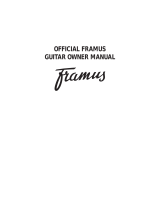Page is loading ...

A-STYLE ACOUSTIC MANDOLIN
WITH ACCESSORIES
RYAMANDOSBA


Read Carefully Before Proceeding
When using a strap, make sure the strap is securely attached to the mandolin.
Refrain from treating the instrument in a rough manner. Do not swing it around.
Do not place your face close to the instrument when changing or adjusting the strings.
After changing the strings, cut off the leftover string ends. Clean the instrument with a soft,
dry cloth.
When cleaning the headstock, be careful not to injure yourself on the sharp string ends.
Broken mandolin necks are mostly the result of accidents such as dropping the instrument,
the instrument falling over or from shocks occurred during transport. When the mandolin is
not be in used, make sure it is kept on a sturdy stand where it won't fall over or place it in the
supplied bag.
Note that images in this user guide are for reference only and may differ to actual design.
Store the Instrument Properly
DO NOT keep the instrument close to a fire or flame and keep it on a low, stable surface.
DO NOT place the instrument in an unstable position where it might accidentally fall over.
DO NOT expose this instrument to direct sunlight, high temperature/humidity or leave
stored in an automobile.
• Mandolin
• Bag
• Tuner
• Replacement string set
• Picks
• Cleaning cloth
SAFETY & WARNINGS
COMPONENTS LIST

OVERVIEW
Headstock
Tuners
Frets (x20)
Pick guard
Bridge
Sound holes
Tailpiece
Strings
Nut
Neck
Strap button

The standard mandolin tuning is the same as violin tuning: G-D-A-E, from low to high.
On a mandolin, you tune each "course" (or pair) of strings to the same pitch, so the
mandolin's tuning is really G-G-D-D-A-A-E-E.
Find the tuners that correspond to each string. Typically, you'll find the tuners for the G and
D strings on the upper side of the head (closest to you) and the tuners for the A and E
strings on the lower side of the head.
Start from the lowest pitch and move to the highest pitch, tuning in a clockwise direction
around the mandolin's head. Tune in pairs. Start by tuning each string individually using a
tuner to get as close to the correct pitch as possible. Then, play the two strings
consecutively and listen to see if they sound the same as one another.
If one sounds higher or lower, adjust it accordingly until both strings are in unison.
Double check the tuning again after you've tuned the E strings. As the tension of each string
changes, the previously tuned strings will have slightly gone out of tune, so will require
further adjustment.
TUNING

Step 1: Study the string slots on the bridge and be aware
that the thicker strings will go into the wider slots.
Generously loosen the strings so that the bridge can sit
upright underneath the strings without any string tension.
Lift the loosened strings and carefully place the bridge
underneath the strings.
Step 2: Centre the bridge between the notches of each F-
hole. If the mandolin has an oval shaped sound hole, place
the bridge behind the sound hole, centered to the body.
Step 3: Tune up the low G string to pitch, making sure it is resting in the appropriate groove
in the nut and the bridge. Play the G string open and fret it at the 12th fret. If the two notes
are the same then the bridge is in the correct position. If the fretted note is flat, move the
entire bridge (not just one side) slightly forward. If the note is flat, move it slightly back.
Step 4: Once the open G and the fretted G are in tune, repeat the same step with the high
E string. Adjust the bridge accordingly.
Step 5: Once the G and the E are intonated, tune up the rest of the strings to pitch and
you're ready to play. Adjust the thumbscrews on the bridge to your preferred string action.
BRIDGE INTONATION

Step 1: Loosen and remove old string
When re-stringing a mandolin, you can save yourself
some later readjustments by changing only one string
at a time.
Step 2: Lift the tailpiece cover
This cover will be attached to the tailpiece at the
bottom of your mandolin. It covers the area where the
strings are attached to the tailpiece and protects your
forearm while playing. This cover should just pop off
the tailpiece by pulling up on it a bit or sliding it down
toward the bottom of the mandolin.
Step 3: Detach the string
The tailpiece at the bottom of your mandolin has eight
hooks on it, where the strings attach. Mandolin strings
usually just have a loop at the end that attaches to
one of the hooks on the tailpiece. You will just need to
pull the loop off of the hook on the tailpiece to detach
the string.
REPLACING STRINGS

Step 4: Hook the loop on your replacement string to
the correct hook on your tailpiece
Be sure you are attaching the correct string, one that
matches the one you just removed. Once hooked on,
keep the string taut so that it doesn't come off the hook.
Step 5: Pull the string up, along the fretboard and up
towards the peg head (tuner)
Make sure that the string is seated properly in the bridge
and the nut, which is located at the top of the fretboard.
These two pieces hold the string centered in place, as
well as off the surface of the body and fretboard.
Step 6: Pull the string tight through the hole then wrap
the string around the post
You want to lock the string in place, so put a kink in it
right where it comes through the hole in the post. Then
wrap the string around the post, locking it in place.
Step 7: Tighten the string by turning the tuner knob
associated with the post it's attached to
You do not need to tune it yet, just make sure the string is
taut and won't slip out of place. Using pliers, clip off any
excess string sticking up off the tuning post.

Wood is an organic, porous material that either absorbs moisture from the air or evaporates
it out into the air, depending on the humidity and temperature of the environment
surrounding it. Like a sponge, when wood absorbs moisture, it swells up and conversely,
when it dries out, it shrinks. One of the greatest threats to the integrity of fine wood is a lack
of attention to maintaining the instruments in the appropriate temperature and humidity
range that will ensure the ideal moisture content in the wood.
The ideal temperature is about 21°C (70°F) and humidity is between 40% and 50%. Take
care of your instruments to ensure longevity.
When the instrument is not in use, we recommend that you keep it in its bag. Do not leave
the instrument out of the case for long periods near a heating vent, radiator or in direct
sunlight near a window. Cracks in the wood are typically caused by changes in temperature
and humidity.
Clean the instrument after each use, making sure to wipe the fingerboard and strings, as
well as any of the plated parts with a soft dry cloth. If you plan to store the instrument for a
long period of time, loosen the strings a bit to relieve the tension, but do not remove them.
Rough, exposed fret edges are evidence of an overly dry and shrunken fingerboard. The
wood will contract as it dries out, but as the frets are inert, you will feel the fret edges begin
to protrude past the edge of the fingerboard.
CLEANING & CARE
Note:
Damage caused to the instrument as the result of exposure to variations in
temperature or humidity will not be replaced by support team.

CHORD CHART

NOTES

Need more information?
We hope that this user guide has given you
the assistance needed for a simple set-up.
For the most up-to-date guide for your product,
as well as any additional assistance you may require,
head online to help.kogan.com
/


